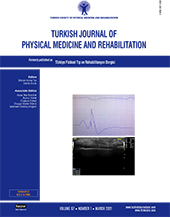Effectiveness of training about kinesiotaping in myofascial pain syndrome: A prospective, single-blind, randomized-controlled study
2 Department of Physical Medicine and Rehabilitation, Medicine Faculty of Dicle University, Diyarbakır, Turkey
3 Department of Physical Medicine and Rehabilitation, Yardımeden Physical Therapy and Rehabilitation Medical Center, Diyarbakır, Turkey
4 Department of Physical Medicine and Rehabilitation, Kütahya Training and Research Hospital, Kütahya, Turkey
5 Department of Physical Medicine and Rehabilitation, Medicine Faculty of Sakarya University, Sakarya, Turkey DOI : 10.5606/tftrd.2021.4258 Objectives: In this study, we aimed to investigate whether there was any difference in kinesiotaping (KT) application on the upper trapezius muscle between a trained and untrained physiatrist in the management of patients with myofascial pain syndrome (MPS).
Patients and methods: Between April 2013 and July 2015, a total of 45 patients (44 females, 1 males; mean age 31.9±8.0 years; range, 18 to 55 years) with MPS were included in this prospective, single-blind, randomized-controlled study. The patients were randomly divided into two groups. The first group (intervention group, n=24) was administered KT band with the muscle in a tense condition according to the muscle technique performed by a trained physiatrist, from the muscle origo toward its insertion point. The second group (control group, n=21) received no technique and KT was applied to the painful area by an untrained physiatrist using a randomly selected method. Primary outcome measures were pain at rest, during activity (0-10 cm visual analog scale), and threshold measurement with algometry (kg/cm2). Secondary outcome measures were function (Neck Pain and Disability Scale), degree of palpable muscle spasm, and quality of life (Nottingham Health Profile). All evaluations were performed at baseline, at three and six weeks after the treatment.
Results: There were significant improvements in all parameters in both groups. There were no significant differences in any parameters at six weeks. We demonstrated that KT, which was applied on active trigger points on the upper trapezius muscle by trained and untrained physiatrists, improved pain, palpable muscle spasm, neck function, quality of life, and patient satisfaction degree in patients with MPS.
Conclusion: Our study results show that KT, which is applied by trained and untrained physiatrists, improves pain, palpable muscle spasm, neck function, quality of life in patients with MPS.
Keywords : Function, kinesiotaping, myofascial pain syndrome, pain, quality of life, training

















